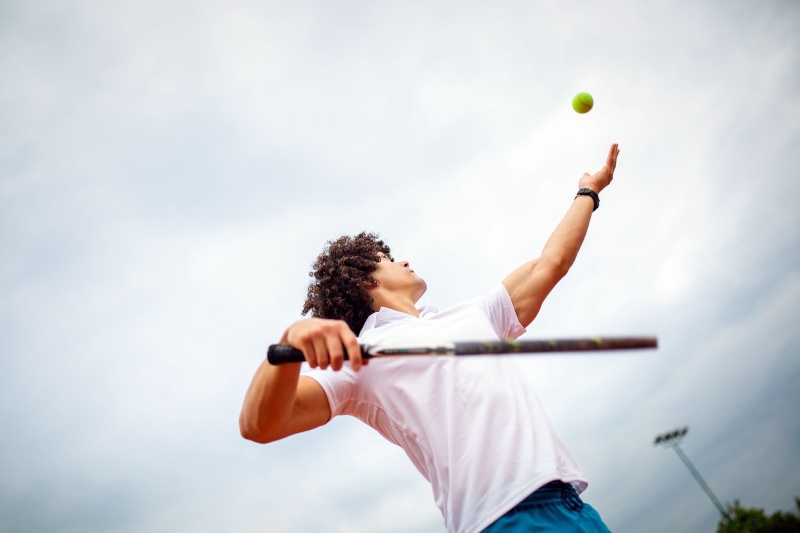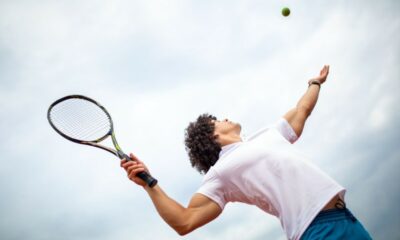Sports
Bert Boksen Describes Mastering the Tennis Serve: Techniques for Power and Accuracy

Welcome to the world of mastering the tennis serve. Are you tired of struggling with your serves and losing points in your matches? Look no further; in this article, Bert Boksen will provide essential techniques to improve your serve’s power and accuracy, helping you dominate the court.
What Is the Tennis Serve?
The tennis serve is the initial shot of the game. The server must hit the ball over the net and into the diagonally opposite service box. This shot is essential for establishing the game’s pace and gaining an advantage. It demands precise technique and can be performed in different styles to achieve power and accuracy.
Why Is the Tennis Serve Important?
The tennis serve is crucial for several reasons:
- Starting the point: It initiates each point, giving the server an immediate advantage.
- Setting the tone: A powerful, accurate serve can intimidate opponents and convey confidence.
- Winning free points: A strong serve can secure easy points, preventing opponents from returning effectively.
What Are the Basic Techniques for a Good Tennis Serve?
This section will cover everything from the grip to the swing, breaking down the key elements contributing to a robust and accurate serve. By mastering these basic techniques, you’ll be well on your way to dominating the court with your serve.
Grip
The grip is a crucial element of the tennis serve, which is fundamental in delivering power and control. Follow these steps to achieve the correct grip:
- Eastern grip is ideal for beginners as it balances power and control.
- Continental grip suits advanced players, allowing for precise ball placement and powerful serves.
- Semi-Western grip provides a middle ground between power and topspin, improving consistency.
- A full Western grip enables aggressive topspin serves, giving an increased spin and kick.
Stance
When it comes to the tennis serve, having the right stance is crucial for executing a robust and accurate serve. Follow these critical steps for the proper stance:
- Stand sideways to the net, with your feet shoulder-width apart.
- Keep your weight evenly distributed on both feet.
- Hold the racket with a relaxed grip, preparing for your swing.
Ball Toss
Perfecting the ball toss in tennis is crucial for a booming serve and involves several key steps:
- Position yourself sideways with your non-dominant shoulder facing the net.
- Hold the ball in your non-racquet hand at waist level.
- Extend your arm and release the ball at the peak of its ascent.
Swing
- Position yourself sideways with your non-dominant shoulder toward the net.
- Hold the racket with an Eastern or semi-Western grip for topspin and power.
- Start the swing by dropping the racket head below the ball toss.
- Drive the racket up and forward, accelerating through contact for a powerful and spin-filled swing.
How Can You Improve Your Tennis Serve?
Practice Consistently
- Establish a consistent practice schedule, dedicating specific times for serve drills and repetitions.
- Prioritize consistency over intensity, ensuring regularity in your practice routine.
- Monitor your progress, taking note of improvements in speed, accuracy, and technique over time.
Focus on Technique
- Position: Ensure correct stance and body positioning for a strong foundation.
- Grip: Master the continental grip for versatility in serves.
- Ball Toss: Practice consistent ball toss to control serve placement.
- Swing: Develop a fluid and explosive swing motion to generate power and focus on technique.
Work on Your Strength and Flexibility
- Incorporate strength training exercises into your workout routine that target the major muscle groups used in the serve, including the shoulders, arms, and core.
- Incorporate flexibility exercises to improve the range of motion in your shoulders, back, and legs, which is crucial for a fluid and powerful serve.
- Add yoga or Pilates to your training regimen to enhance flexibility and stability.
Get Professional Coaching
- Hire certified tennis coaches with a proven track record of training successful players.
- Communicate your goals with the coach to customize the training program to fit your needs.
- Commit to attending regular sessions to receive continuous feedback and strategies for improvement.
- Incorporate video analysis to pinpoint areas for improvement and track your progress.
What Are Some Common Mistakes to Avoid in the Tennis Serve?
From using the correct grip to positioning your body correctly, each aspect of the serve plays a crucial role in its success. You can take your service to the next level by recognizing and correcting these common errors.
Not Using the Right Grip
- Use a Continental or Eastern grip to have better versatility and control.
- Check the pressure of your grip to avoid holding the racket too tightly, which can hinder wrist action.
- Position the base knuckle of your index finger against bevel 2 for a Continental grip or bevel 3 for an Eastern grip.
Poor Ball Toss
- Improper placement: To avoid a poor ball toss, toss the ball slightly in front and to the side rather than directly above your head.
- Consistency: For a consistent toss, practice aiming for the same spot each time and maintaining a steady rhythm.
- Height: Toss the ball to a height where your racquet can make contact at its highest point for optimal power and accuracy.
- Avoiding spin: To maintain control over the direction, release the ball with a flat palm and minimal spin.
Incorrect Body Positioning
- Stand sideways with your non-dominant shoulder pointing towards the net.
- Keep your feet shoulder-width apart, with your body weight on the back foot.
- Maintain a slight bend in your knees and hips to prepare for the explosive movement.
- Position your tossing arm straight up with the ball at your fingertips.
Lack of Follow-Through
When serving in tennis, failing to follow through can significantly affect the power and accuracy of the shot. It is crucial to maintain the swing after making contact with the ball, extending the racket towards the intended target. This ensures the transfer of energy and control over the direction of the service. Without proper follow-through, serves may lack speed and precision.
How Can You Add Power and Accuracy to Your Tennis Serve?
From using your body weight to generating more racquet head speed, each approach has its unique benefits.
Use Your Body Weight
- Incorporate your body weight transfer by beginning with your body facing away from the net and then rotating your shoulders and hips towards the net while making the serve.
Generate More Racquet Head Speed
- Utilize proper grip and stance to optimize leverage.
- Engage core muscles and shoulder rotation for increased speed.
- Focus on timing and coordination to synchronize racquet movement.
- Follow through fully to maximize racquet head velocity.
Focus on Your Contact Point
- Positioning: To ensure maximum extension of your hitting arm, make sure your contact point is slightly in front and to the side of your body.
- Timing: Coordinate your ball toss and body rotation to meet the ball at the ideal contact point.
- Consistency: Consistently hitting the ball at the same contact point will improve your accuracy and power.
-

 Tech3 weeks ago
Tech3 weeks ago12 Essential Marketing Tools Every Small Business Owner Should Try
-

 Startup2 weeks ago
Startup2 weeks agoEssential Tips for New Retail Business Owners to Succeed in a Competitive Market
-

 Tech4 weeks ago
Tech4 weeks agoHow Small Business Can Start with Marketing Automation Software
-

 Tech1 week ago
Tech1 week agoAdobe Partner with Benny Blanco to Help Small Business Branding in ‘Create Anything’ Campaign
-

 Business3 weeks ago
Business3 weeks ago7 Essential Investment Success Tips Every Investor Should Know: How to Beat the Market
-

 Tech4 weeks ago
Tech4 weeks agoGoogle’s Change to Google Local Services Ads Could Have an Impact on Millions of Small Businesses
-

 Festivals & Events2 weeks ago
Festivals & Events2 weeks agoKrispy Kreme is Celebrating World Kindness Day by Offering Free Donuts to Early Customers
-

 Business3 weeks ago
Business3 weeks agoSteps to Establish Your Business Credit for Any New Small Business



















